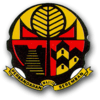Seremban
| Seremban | ||
|---|---|---|
|
| ||
| ||
| Nickname(s): Somban | ||
| Motto: 5S The Foundation of Work Excellence | ||
 Seremban Location of Seremban in the Malaysian peninsula | ||
| Coordinates: 2°43′N 101°57′E / 2.717°N 101.950°E | ||
| Country | Malaysia | |
| State | Negeri Sembilan | |
| District | Seremban District | |
| Establishment | 1840 | |
| Granted municipal status | 1979 | |
| Government | ||
| • Administered by | Majlis Perbandaran Seremban | |
| • Yang DiPertua (President) | Dato' Haji Abd. Halim [1] | |
| Area | ||
| • City | 959 km2 (370 sq mi) | |
| • Metro | 2,980 km2 (1,150 sq mi) | |
| Elevation | 79 m (259 ft) | |
| Population (2010)[2] | ||
| • City | 555,935 (9th) | |
| • Density | 489.00/km2 (1,266.51/sq mi) | |
| • Metro | 806,920 [3] | |
| • Demonym | Serembanese | |
| Time zone | MST (UTC+8) | |
| • Summer (DST) | Not observed (UTC) | |
| Postal code | 70xxx to 75xxx | |
| Mean solar time | UTC + 06:46:48 | |
| National calling code | 06 | |
| License plate prefix | Nxx (for all vehicles include taxis) | |
| ISO 3166-2 | MY-14 | |
| Website |
www | |
Seremban (Jawi: سرمبن) is the capital of the Malaysian state of Negeri Sembilan, located within the district of Seremban, one of the seven districts of Negeri Sembilan. The town's administration is run by the Seremban Municipal Council also known as Majlis Perbandaran Seremban. On 9 September 2009, Seremban was to be declared as a city, however it was later deferred due to technical reasons. However, the idea of granting city status has been brought up again and Seremban is expected to become a city on 9 September 2013.
Toponymy
Seremban was originally founded as Sungei Ujong (or Sungai Ujong), named after a nearby river of the same name. While the town was renamed Seremban thereafter, the Sungai Ujong name most prominently persists as a street name for a road adjoining the southern side of town (Sungai Ujong Road, or Jalan Sungai Ujong).
The town is also referred alternately as "Fu Yong" (Chinese: 芙蓉) among the Chinese-speaking community, although the name is unrecognised officially.
History
Sungai Ujong came into existence with the discovery of tin ore in the 1870s like most major towns in Peninsular Malaysia. The discovery of tin in a nearby area called Rasah, saw an influx of Arab, Malay and Chinese immigrants to work on the mines and trade there. Most of the local Malays were farmers.
Renamed to Seremban, the town flourished not only as a mining area but also a business centre. The Linggi River served as the sole outlet to ferry tin and supplies in and out of the town. Revenue came not only from tin trade but also from the large amount of taxes collected, much to the displeasure of the traders and the British colonialists at the neighbouring port of Malacca.
The local chieftains, namely the Dato’ Kelana and the Dato’ Shahbandar of Sungai Ujong were at odds with each other on the rights to collect taxes and ownership and control of the mines. The rivalry to assert influence and authority opened the door for British intervention in Negeri Sembilan. The British sided with the Dato’ Kelana upon invitation and defeated the forces of the Dato’ Bandar who was later sent into exile to Singapore. In a show of gratitude to the British for helping him win the war, the Dato’ Kelana had no choice but to accept a British Resident whose job was to advise him on matters other than religion and Malay customs.
Captain Murray was appointed the first resident and later set-up his residence at Channer Road, now renamed Jalan Dato’ Siamang Gagap. Soon after, the people living around Rasah moved to Channer Road for the sake of security and its orderly administration.[4]
City status
Seremban is one of four state capitals that has not achieved city status (Bandar raya) other than Kota Bharu, Kuantan and Kangar. However, the Ministry of Housing and Local Government has approved Seremban to be declared a city by 9 September 2009. To achieve the city status, the state government has agreed that Majlis Perbandaran Nilai and Majlis Perbandaran Seremban will be merged.[5]
Mentri Besar Datuk Seri Mohamad Hasan said during the Tuanku Muhriz birthday
| “ | The state government wants to ensure all the necessary infrastructure, public transport and amenities and services which include garbage collection and safer neighbourhoods, were in place before it did so.[6] | ” |
Geography
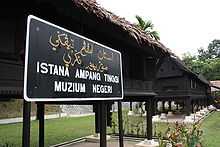
Seremban is situated about 30 kilometres inland from the coast. It is in the Linggi River valley, at the foothills of the Titiwangsa Range. The terrain is generally hilly, and the soil is mostly reddish laterite soil, suitable for the cultivation of rubber and palm oil, thus making Seremban the agricultural centre for the state. Since the establishment of Seremban, the Linggi River has played an important role in the development of the town. During the boom period of tin mining, the Linggi River was the major transportation route for tin traders. Today, it is one of the major sources of water for Seremban and Negeri Sembilan.
Weather
The climate of Seremban, like most parts of West Malaysia, is generally hot and humid (tropical) with a mean temperature of about 27-30 degrees Celsius. Most rainfall is experienced during the inter-monsoon periods of April and October. The weather remains generally dry for the rest of the year with occasional showers.
Transportation
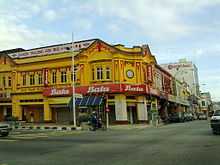
The rail connection was first constructed in the late 1890s as a stop on the Kuala Lumpur-Singapore main line, and until today, the Seremban railway station still serves as one of the major stops along the line. Seremban station also serves as the southern terminal of the Keretapi Tanah Melayu electrified commuter network, KTM Komuter, which links the town to Kuala Lumpur and the Klang Valley on Rawang-Seremban Line.[7]
Federal Route ![]() , the oldest major roadway that connects the major towns and cities of the West Coast of Peninsular Malaysia runs through Seremban. It connects Seremban with neighbouring towns such as Rembau and Tampin to the south and Kajang, Selangor to the north. Seremban also provides access to the towns of Kuala Klawang and Kuala Pilah to the east and the well-known coastal town of Port Dickson to the west.
, the oldest major roadway that connects the major towns and cities of the West Coast of Peninsular Malaysia runs through Seremban. It connects Seremban with neighbouring towns such as Rembau and Tampin to the south and Kajang, Selangor to the north. Seremban also provides access to the towns of Kuala Klawang and Kuala Pilah to the east and the well-known coastal town of Port Dickson to the west.
Negeri Sembilan is one of the two states in Malaysia that are not accessible via air transportation (Perlis being the other state). However the Kuala Lumpur International Airport (KLIA) is less than a 30 minutes drive from Seremban, essentially making the airport closer to Seremban rather than Kuala Lumpur.
Culture

Historically, Negeri Sembilan is influenced by the Minangkabau's and thus, Seremban is the centre of the Minangkabau culture in Malaysia. Minangkabau, derived from the Malay word menang kerbau, which means "winning buffalo", are famous for their unique roof architecture which resembles buffalo horns. Many buildings in Seremban adapted this feature, such as the Seremban Municipal Council Hall, the Wisma Negeri and the State Museum.
People of Negeri Sembilan are also known for the practice of an ancient Malay tradition called Adat Perpatih, where women are given a higher social status than men.
Sports
Seremban currently serves as the home ground of Negeri Sembilan football team. The team is the state representative of Negeri Sembilan in the top tier Malaysia Super League. They play their home games in the 30,000 capacity Tuanku Abdul Rahman Stadium which is located in Paroi on the outskirt of the city.
Cuisine
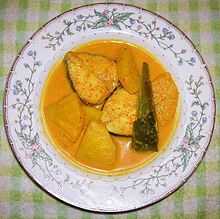

Seremban is famous for its special delicacies comprising Malay, Chinese, and Indian cuisine. Among the famous local cuisine is Seremban Siew Pau (Chinese: 芙蓉烧包) that is well known throughout the country. It is flaky pastry bun filled with meat fillings either pork, the traditional flavour or chicken which is halal.[8]
Aside from the famed Siew Pau, Seremban is also well known for its Nasi Padang or Minangkabau dishes. It is rich in coconut cream and is generally accompanied by a generous serving of cili padi (bird's eye chili).
Apparently Seremban is famous for baked crabs (Chinese: 芙蓉烧蟹)[9] and beef noodles (Chinese: 牛腩粉),[10] especially the beef noodles food stalls here which had survived more than a generation. Nowadays, this famous beef noodles attracted a lot of tourists outside from the state to Seremban here with its thick slick gravy and sprinkled, peppery sticky sauce with peanuts, salted vegetables, spring onions and sesame seeds.
Local desserts include ABC or air batu campur meaning shaved ice with brown sugar syrup and rose flavouring, corn, beans, and cendol.
Economy
The state, which been home to a number of multinationals from Japan, South Korea, the United States and the European Union. The manufacturing sector today forms the backbone of the state economy, contributing almost half of the state’s gross domestic product (GDP), followed by services and tourism (40.3%), agriculture (6%), construction (2.2%) and mining (0.3%).[11]
Retail
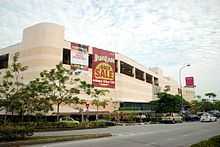
Seremban is the business and commercial centre for most towns and villages in Negeri Sembilan. During the weekends, residents from outlying areas come to Seremban by commuter train or buses to shop in Seremban. Amway opened their first concept shop in Seremban in August 2008 as on-going expansion strategy to give its distributors and customers a new shopping experience.[12]
Terminal One Shopping Centre ("T1", previously known as Terminal One Mall) is located at the heart of Seremban. It was built in 1996.Parking is located in the building with rate maximum RM5 per day. Lost ticket will be penalised RM50.[13][14]
AEON Seremban 2, one of the premier shopping destinations in the town, was the only ÆON outlet operated in the state.
Besides T1 and AEON Seremban 2, many shopping outlets are concentrated in town centre; Wisma Punca Emas, KM Plaza, Parkson Seremban Prima replace Seremban Parade, The Store, Palm Mall and Era Square. As the population increases from time, it attracted two major hypermarkets in Malaysia, namely Giant Hypermarket, Tesco Extra, Econsave to open their outlet here and on February 2010, ÆON launched their grand opening at Seremban Forest Heights which replace Carrefour.
Apart from shopping complexes, Seremban has designated numerous zones in the city to market locally manufactured products such as antiques, textiles, fabrics and handicrafts. Local municipal council has gazetted Jalan Utam Singh as morning flea market during weekend.[15] In 2009, Sungai Ujong Walk located in Jalan Dr. Murugesu was opened by local council president. The walk is using the Malacca well known Jonker Street and was provided 72 business site where 30 sites will sell food and beverage while the rest is general requirement in the area besides providing stage to enable any show or cultural shows held. It is perceived as a future location that will revive night atmosphere apart from enliven the area around.[16]
Infrastructure
Health
Seremban has a number of hospitals and medical centres, which include a government hospital and private owned hospitals.
Tuanku Ja'afar Hospital, formerly known as Seremban General Hospital is the state and referral hospital for the state of Negeri Sembilan. Established in 1930 with total capacity 800 beds and 20 clinical specialities and various supportive services. Situated at Bukit Rasah, Seremban, the hospital occupying an area of 212 acres (0.86 km2) of land.
The other hospitals include Columbia Asia Medical Center, which opened in 1999 and now has 80 beds and offers outpatient and inpatient specialist services, a 24-hour clinic and emergency services.
In 2004 a new hospital was established, Seremban Specialist Hospital which has total capacity of 109 beds. The hospital located at the outskirt of Seremban which is just behind State Museum.
Negeri Sembilan Chinese Maternity Hospital is also a private hospital that has 75 beds. It located along Jalan Tun Ismail.
There is also a hospital in Senawang, the 101 beds Senawang Specialist Hospital (SSH) which opened in 2008.
Gallery
-

Street map of Seremban attractions
-

KTM Komuter station
-

Seremban Parade
-
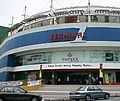
Terminal One Mall
-

Era Square
-

Menara MAA
-

Church of the Visitation Seremban
-

Wesley Church Seremban
Sister cities
Although Seremban does not have a city status, it has nevertheless four sister cities.
See also
References
- ↑ Rashitha A. Hamid (16 June 2007). "Profile of Haji Abd. Halim". Majlis Perbandaran Seremban. Retrieved 29 August 2007.
- ↑ Helders, Stefan. "Metropolitan areas in Malaysia". World Gazetteer. Retrieved 4 December 2007.
- ↑ Seremban Urban Area
- ↑ "Administration in Seremban". Majlis Perbandaran Seremban. Archived from the original on 8 January 2008. Retrieved 14 February 2008.
- ↑ "City status for Seremban". Utusan Malaysia. Retrieved 14 February 2008.
- ↑ "Seremban on the right track". The Star (Malaysia). 14 January 2011. Retrieved 24 February 2011.
- ↑ "Commuter service in Seremban". Keretapi Tanah Melayu Berhad. Archived from the original on 11 October 2007. Retrieved 14 February 2008.
- ↑ Lee Thean Seng. "The Legendary of Siew Pau". Lee Thean Seng. Retrieved 30 July 2011.
- ↑ "Seremban Baked Crabs". Retrieved 25 October 2011.
- ↑ Thomas. "Seremban Beef Noodles". Thomas. Retrieved 21 September 2011.
- ↑ "Multi-pronged approach to maintain growth". The Star (Malaysia). 14 January 2011. Retrieved 24 February 2011.
- ↑ "Outlet is direct-selling company’s first in the Klang Valley". The Star (Malaysia). 4 August 2009. Retrieved 27 August 2009.
- ↑ "Seremban council takes over bus terminal". Fox News. 16 October 2003. Retrieved 26 January 2008.
- ↑ Terminal One Shopping Centre
- ↑ Mohd. Yassir Jaafar (16 March 2009). "Keunikan Pasar Warisan". Utusan Malaysia. Retrieved 26 August 2009.
- ↑ "Sungai Ujong Walk bakal tandingi Jonker Street". Utusan Malaysia. 6 December 2008. Retrieved 4 October 2009.
- ↑ "Bukittinggi: Jabaran Rencana Kota Kembar" (in Indonesian). Bukittinggi Department. Retrieved 10 July 2013.
External links
| Wikimedia Commons has media related to Seremban. |
-
 Seremban travel guide from Wikivoyage
Seremban travel guide from Wikivoyage - Majlis Perbandaran Seremban
- KTM Komuter Seremban Station
- Seremban Maya
- Virtual Drive Through Street of Seremban
- Seremban Live
| ||||||||||||||||||||||
| ||||||||||||
